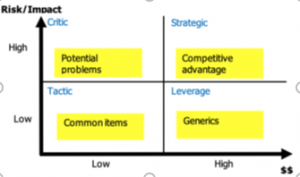Sourcing is the process of ordering materials to sustain the activities of a business. Many aspects must be considered when defining a sourcing strategy, not only price.
For instance, procurement professionals should be aware of what is called “Price Iceberg”, which includes delivery, delays, handling, among others.
A well-structured supply chain sourcing is essential to companies that want to maintain itself competitive. It will help with costs, reduce negative effects, and provide quality goods and services.
Not only that, but it will also be an important aspect of your lead time. A good sourcing will make your process more efficient. The main principle of sourcing is the relationship between buyer and supplier.
Procurement’s two-by-two matrix for sourcing
One initial step to define a procurement strategy is creating a two-by-two matrix called The Kraljic Matrix that will divide items in basically two types: the supply risk and the annual spend.

Figure 1 Risk-spend Framework – MIT MicroMasters SCM
In the Kraljic Matrix, risk means unexpected events in the supply chain that can negatively impact operations. On the other hand, profitability means the impact of an item in the supply chain’s bottom line.
Low risk
So, each quadrant of the matrix represents an item species that follows its importance on the supply chain. On the bottom-left there’s the non-critical items, they have the least impact on business and the best strategy is to focus on efficiency.
Above them, we have the leverage items. They have a high profitability but low risks factors. They are abundant and suppliers can be easily substituted.
High risk
On the other side of the matrix are the high-risk items. They should be treated with more care and strategy because they can cause negative impacts on business.
First there’s bottom-right, which are the bottleneck items. They represent a high risk with low profitability. They are the opposite of leverage; supplier has the upper hand. The market consists in a few suppliers that can force prices upward.
Even with a relatively low impact on profit, the market structure may force buyers to accept deals that aren’t ideal. Here the strategy is damage limitation. Procurement professionals must recognize better opportunities and take it.
Finally, on the top-right we have the strategic items. They are the critical items for business not only because have high impact on profit and supply but also because they ensure the substance of the company.
The strategy with those items resides in having contracts that will benefit both companies. Strategic partners must be innovative and proactive to make long-term commitments and ensure the viability of the business.
General sourcing process
Generally, the process of sourcing follows a few basic steps, they are:
- Internal assessment: the first phase refers to a inside process. You must define baselines for your own business and understand what’s the key features of it.
- Market assessment: at this point you already understand what your business is. Now you must analyze market dynamics, identify strategic partners, and understand competitors.
- Collect supplier information: now that you know how the market works, you define criteria for supplier and seek the ones that correspond to what you need.
- Sourcing strategy: after the initial assessments, you can define what your sourcing strategy will be. It specifies how you’ll approach your supplier and deal with stock.
- Bidding process: here the request for proposals is developed and sent. Here’s the point where the buyer defines a bidding format and short-list suppliers.
- Negotiate and select here the buyer will get in touch with suppliers and decide which ones attends the specifications. This step will lead to a selection of suppliers.
- Contract: now you can develop your implementation and audit plans. Choose your strategic partners and start to make a solid foundation for your sourcing.
What’s value-based sourcing?
In a context of modern supply chains, where it becomes more global and complex, procurement must deliver genuine value to the operations. That means dealing with huge amounts of data and making right decisions for sourcing.
Value-based sourcing looks for a range of factors that will impact long-term cost and open new opportunities and possibilities. So, value-based sourcing is a method that looks beyond upfront cost.
Synthetically, value-based sourcing tries to foresee value that are not contained in the purchase price. For instance, what other assets the supplier can offer in addition to the product or service procured?
To establish a culture of value-based sourcing, you can ask a couple of questions:
- Is the supplier better with existing activities? Such as inventory management, after sales support or product development?
- Will the supplier decrease risk?
- How the supplier will provide other competitive advantage?
- Can the supplier help expand portfolio to address new customer needs?
All of those will make the relationship between buyer and supplier more active and result in advantages for both. This relationship must also consider some strategic aspects.
Buyer and Supplier relationships
A relationship between buyer and supplier is sustained by communications, contracts, and involvement. But it changes focus depending on the item ordered.
If you’re dealing with low value products, that doesn’t offer a lot of risks and are simply found in supply market, the relationship will assume a transaction focus.
On the other hand, high value products with greater risks that need a complex supply market will demand a collaboration focus. That will be more strategic and aggregate value both to buyer and supplier.
Conclusion
The traditional sourcing will focus on price. It’s based in a total cost of ownership and process-driving sourcing. The main point of research is comparability involved in spec definition.
A value-based sourcing will focus on value, not only product price. It considers the total contribution of the supplier and seek a strategic intent sourcing. Differentiation is important for value-based sourcing because it will reflect on more strategic issues.
Implementing a value-based strategy is challenging, but it will establish a unique relationship between buyers and suppliers. But that will result in solutions that best suit the outcomes needed. Reducing the total cost and making the operation more profitable
With a tool that intelligently automates repetitive and operational processes, the purchasing area gains time and productivity to devote effort to strategic tasks. Meet Supply Brain, free up time!

